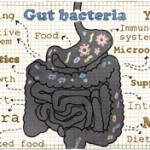For the first few weeks, before the diet shifted, the microbiome was relatively stable, Dr. Turnbaugh said. As soon as the Western diet was started, there was “really a dramatic departure,” which then leveled out after three days. But then it “snapped back immediately” when the low-fat diet was resumed.
“This was really surprising to us—despite the fact that these mice are all very genotypically diverse, their microbiomes seemed to be responding very similarly,” he said.
The lab also found that the changes in the microbiome seem to be dose dependent, with the extent of dietary changes appearing to dictate the extent of the changes to the gut’s organisms.
Researchers in his lab are now looking at the effects of food preparation on the microbiome.
“We now know that diet plays a major role—if not the dominant role—in shaping our microbiome,” Dr. Turnbaugh said. “These changes are important, both in terms of changing the structure of the community and also their function.”
Helminths

Dr. Weinstock
Joel Weinstock, MD, professor of medicine and gastroenterology at Tufts University, described his lab’s work in trying to glean insights from the way helminths, worm-like parasites, affect the immune system, in an effort to find new therapeutic approaches to inflammatory bowel disease—insights that could eventually translate to rheumatic diseases.
Helminths used to be in everyone’s gastrointestinal tract, but not anymore; they have fallen away with modern-day sanitation. Those who carry helminths have different immune characteristics than those who don’t; for example, there are differences in responses to vaccinations.
Through a series of experiments in mouse models of inflammatory bowel disease, researchers have found that infecting them with worms limits inflammation compared with those that have not been infected.3 Adaptive immunity is blocked at two points by the worms, Dr. Weinstock said, by dendritic cells at one point, and by regulatory T cells at another.
He said that, by determining how worms modulate host immunity, the medical world may be able to use this knowledge to develop new approaches to help control immune-mediated diseases.
“The key thing is that the worms have had 100 million years to figure out how our immune systems work and how to modulate our immune function,” he said. “We’ve been at it only 100 years. We are trying to find drug targets that could be effective at controlling disease.”
“Understanding how these organisms work to regulate us to protect themselves from immune attack may afford us new insights into pathways of immune regulation useful in controlling disease. We may find molecules in worms, or perhaps there are molecules already in the pharmaceutical industry, that can target these pathways, which will help at controlling inflammation in the gut or elsewhere.”


